
The Metropolis of Wallachia and Dobruja, headquartered in Bucharest, Romania, is a metropolis of the Romanian Orthodox Church.

The Metropolis of Wallachia and Dobruja, headquartered in Bucharest, Romania, is a metropolis of the Romanian Orthodox Church.

The Metropolis of Ungro-Wallachia was created, in 1359, by Callistus I, the Ecumenical Patriarch of Constantinople as the most senior church office of the Patriarchate of Constantinople, covering the territory of Wallachia.
In 1872, the Metropolis of Ungro-Wallachia united with the Metropolis of Moldavia to form the Romanian Orthodox Church. The Metropolis of Ungro-Wallachia, who received the title of Primate Metropolitan in 1865, became the head of the General Synod of the Romanian Orthodox Church. In 1990, it became Metropolis of Muntenia and Dobruja.

Wallachia or Walachia is a historical and geographical region of Romania. It is situated north of the Lower Danube and south of the Southern Carpathians. Wallachia is traditionally divided into two sections, Muntenia and Oltenia. Dobruja could sometimes be considered a third section due to its proximity and brief rule over it. Wallachia as a whole is sometimes referred to as Muntenia through identification with the larger of the two traditional sections.

The Romanian Orthodox Church, or Patriarchate of Romania, is an autocephalous Eastern Orthodox church in full communion with other Eastern Orthodox Christian churches, and one of the nine patriarchates in the Eastern Orthodox Church. Since 1925, the church's Primate bears the title of Patriarch. Its jurisdiction covers the territories of Romania and Moldova, with additional dioceses for Romanians living in nearby Serbia and Hungary, as well as for diaspora communities in Central and Western Europe, North America and Oceania. It is the only autocephalous church within Eastern Orthodoxy to have a Romance language for liturgical use.

Nicholas Alexander, was a Voivode of Wallachia, after having been co-ruler to his father Basarab I.
The Archdiocese of Tomis is a diocese of the Romanian Orthodox Church within Constanța County. It is part of the Metropolis of Muntenia and Dobrudja. The seat is in Constanța. It is headed by Archbishop Teodosie Petrescu.
The history of Christianity in Romania began within the Roman province of Lower Moesia, where many Christians were martyred at the end of the 3rd century. Evidence of Christian communities has been found in the territory of modern Romania at over a hundred archaeological sites from the 3rd and 4th centuries. However, sources from the 7th and 10th centuries are so scarce that Christianity seems to have diminished during this period.
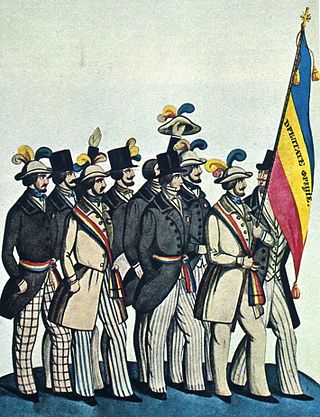
The Wallachian Revolution of 1848 was a Romanian liberal and nationalist uprising in the Principality of Wallachia. Part of the Revolutions of 1848, and closely connected with the unsuccessful revolt in the Principality of Moldavia, it sought to overturn the administration imposed by Imperial Russian authorities under the Regulamentul Organic regime, and, through many of its leaders, demanded the abolition of boyar privilege. Led by a group of young intellectuals and officers in the Wallachian Militia, the movement succeeded in toppling the ruling Prince Gheorghe Bibescu, whom it replaced with a Provisional Government and a Regency, and in passing a series of major progressive reforms, announced in the Proclamation of Islaz.
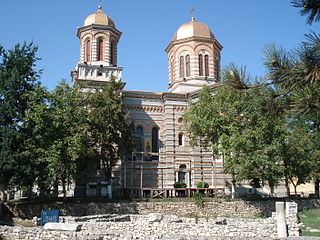
The Cathedral of Saints Peter and Paul, Constanța, located at 25 Arhiepiscopiei Street, Constanța, Romania, is the seat of the Romanian Orthodox Archbishop of Tomis, as well as a monastery. Situated between Ovid Square and the Black Sea in front of the Archbishop's Palace, it was built on the city's peninsular zone in 1883-1885 following plans by architects Alexandru Orăscu and Carol Benesch and, for the interior, Ion Mincu. The cornerstone was laid on 4 September 1883, during the reign of Iosif Gheorghian, Metropolitan of All Romania. The church was consecrated on 22 May 1895.

The Metropolis of Moldavia and Bucovina, in Iași, Romania, is a metropolis of the Romanian Orthodox Church.
The Archdiocese or Archbishopric of Arad, formerly the Bishopric of Arad is an episcopal see of the Romanian Orthodox Church, under the administration of the Metropolis of Banat, with jurisdiction over Arad County in Romania. The current head is bishop Timotei Seviciu.

The Archdiocese of Râmnic is a Romanian Orthodox archdiocese based in Râmnicu Vâlcea, Romania, in the historic region of Oltenia, and covering Vâlcea County. Established in 1503-1504, although with a bishop residing there from the previous century, it is a continuation of the medieval Metropolis of Severin. Initially covering all of Oltenia, it saw a flourishing cultural and religious output during the 16th to 18th centuries, both in the see and in the monasteries of the region. The area of the diocese began to fall in 1939, reaching its current proportions in 2008, a year before it became an archdiocese.

The Diocese of Caransebeș is a Romanian Orthodox diocese based in Caransebeș, Romania, in the historic region of the Banat, and covering Caraș-Severin County. Established by the 17th century, it was moved to present-day Serbia during the 18th century, before being restored in 1865. It was dissolved in 1949 and revived in its current form in 1994.

Mihai or Mihail Iștvanovici, also known as Ișvanovici, Iștanovici, Ștefanovici or Stepaneshvili, was a Wallachian typographer, letter cutter, typeface designer, Eastern Orthodox clergyman and poet, mainly noted for his work in the Kingdom of Kartli. His early life is entirely obscure, but possibly tied to the Transylvanian Principality, and his surname has been read by some authors as indicative of a more of less distant Hungarian origin—though his presumed father was a Serb. His debut as a printer was registered at Snagov Monastery, outside the Wallachian capital of Bucharest, but in 1699 he was active at Alba Iulia in Transylvania. Sent there by the Wallachian Prince Constantin Brâncoveanu, who reinforced links with the Transylvanian Romanians, Iștvanovici put out the first-ever textbook in the Romanian language. He disappeared from Transylvanian records soon after, possibly due to increased pressures for a communion with Rome—which Brâncoveanu and Iștvanovici opposed.

The Archdiocese of Argeș and Muscel is a diocese of the Romanian Orthodox Church. Its see is the Dormition of the Theotokos Cathedral in Curtea de Argeș and its ecclesiastical territory covers Argeș County. The archdiocese forms part of the Metropolis of Muntenia and Dobrudja.
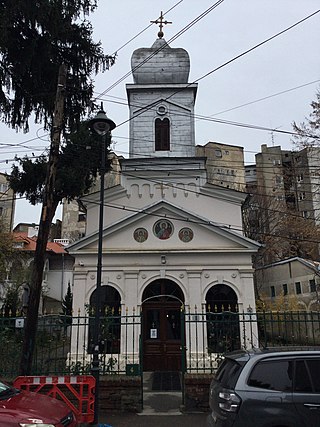
The Oțetari Church is a Romanian Orthodox church located at 4 Oțetari Street in Bucharest, Romania. It is dedicated to the Archangels Michael and Gabriel and to Saint Nicholas.
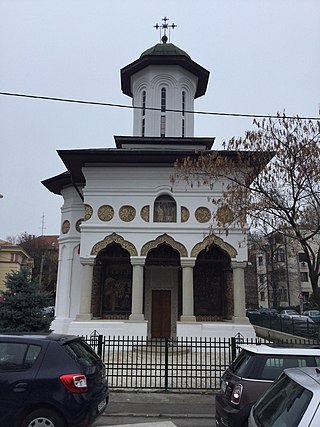
The Old St. Eleftherios Church is a Romanian Orthodox church located at 15B Sfântul Elefterie Street in Bucharest, Romania. It is dedicated to Saint Eleftherios and to Saint George.
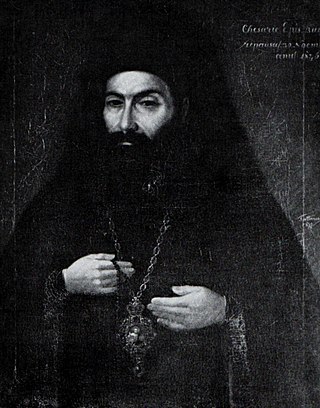
Chesarie Căpățână was a Wallachian bishop.
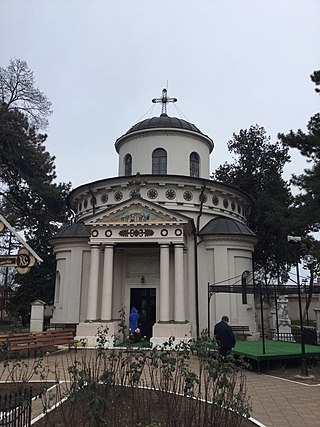
The Teiul Doamnei Ghica Church is a Romanian Orthodox church located at 3 Doamna Ghica Street in Bucharest, Romania. It is dedicated to the Feast of the Ascension.
Ioan (Ion) Răuțescu was a Romanian priest, historical monographist, paleographer, collector of old documents, publicist and folklorist who mainly dealt with researching the history of the Muscel area, writing four monographs dedicated to the mentioned area, works awarded by the Romanian Academy, History Section.